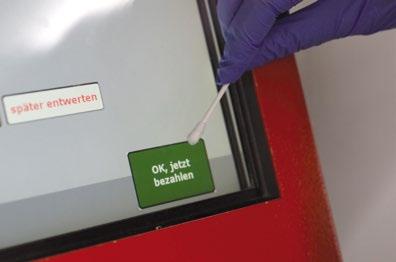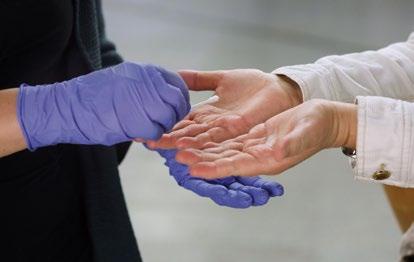
4 minute read
Ein Rätsel, das man lösen muss
“A riddle that has to be solved”
Alexandra Graf erforscht die Welt der Mikroorganismen. Sie ist fasziniert von ihrer Komplexität und will herausfinden, ob Städte individuelle Mikrobiome haben.
Advertisement
Die Idee stammt aus New York. 2013 hat man dort begonnen, Umweltproben in U-Bahnen zu nehmen und das Mikrobiom der Stadt zu untersuchen. Aus der Idee wurde bald mehr. „MetaSUB“ ist heute eine weltweite Forschungsinitiative, an der Forscher*innen aus insgesamt 100 Städten teilnehmen. Die Bioinformatikerin Alexandra Graf ist eine von ihnen. Seit 2017 analysiert sie, welche Mikroorganismen für Wien typisch sind.
Haben Städte einen mikrobiellen „Fingerabdruck“, Frau Graf?
Wir versuchen gerade, das mit unserer Forschungsarbeit herauszufinden. Im Rahmen von MetaSUB sammeln wir große Datenmengen und analysieren sie. Der Interpretationsspielraum ist dabei zum Teil noch sehr groß. Es gibt beispielsweise Korrelationen zwischen Städten wie Lissabon und New York, doch wir wissen bisher nicht warum. Ein möglicher Ansatz, Städte identifizierbar zu unterscheiden, könnte vielleicht ihr pflanzliches Mikrobiom sein.
Welchen praktischen Nutzen hat es, sich so intensiv mit dem Mikrobiom von Städten zu beschäftigen?
Unsere Hoffnung ist, dass wir mit regelmäßigen MikrobiomAnalysen Krankheitserreger leichter und schneller finden können. Es gibt bereits einige Publikationen, die besagen, dass die
Alexandra Graf researches the world of microorganisms. She is fascinated by its complexity and wants to find out whether cities have individual microbiomes.
The idea came from New York. In 2013, researchers started taking environmental samples in subways and examining the city’s microbiome. The idea soon turned into more. Today, "MetaSUB" is a global research initiative with researchers participating in a total of 100 cities around the globe. The bioinformatician Alexandra Graf is one of them. Since 2017, she has been analyzing which microorganisms are typical in Vienna.
Do cities have a microbial “fingerprint”, Ms. Graf?
We are trying to find out with our research. As part of MetaSUB, we collect a huge amount of data and analyze it. The scope for interpretation is still very large in some cases. For example, there are correlations between cities like Lisbon and New York and we still don't really know why. One possible approach to identifying cities could be their plant microbiome.
What are the practical applications of studying the microbiome of cities so intensively?
Our hope is that with regular microbiome analyses we can find pathogens more easily and quickly. Some publications already claim that the corona pandemic could have been predicted on the basis of microbiological analyses of wastewater. These are important findings that we in the MetaSUB consortium are also
Corona-Pandemie anhand mikrobiologischer Analysen von Abwässern vorhergesagt hätte werden können. Das sind wichtige Erkenntnisse, mit denen auch wir uns im MetaSUB-Konsortium näher beschäftigen. Deshalb werden wir die Wiener U-BahnProben heuer erstmals auf Corona-Viren testen. Die New Yorker Kolleg*innen haben das in ihrer Stadt bereits getan und wir alle warten gespannt auf die Auswertungen.
Ergänzend zu Ihrer Forschungsarbeit im MetaSUB-Konsortium haben Sie im Herbst 2019 das MetagenApp-Projekt abgeschlossen. Worum ging es dabei konkret?
Wir haben uns mit der Frage beschäftigt, ob sich das Mikrobiom unserer Handflächen ändert, wenn wir mit der U-Bahn fahren.
Zu welchen Ergebnissen sind Sie gekommen?
Offensichtlich tragen wir das auf Oberflächen in U-Bahnen vorhandene Mikrobiom nicht sehr lange mit uns herum. Es gab zwar Unterschiede vor und nach dem U-Bahn-Fahren, das Hautmikrobiom auf den Handflächen unserer Testpersonen blieb aber im Wesentlichen stabil.
Sie haben im Rahmen des Projektes auch eine App entwickelt. Was hat es damit auf sich?
Wir haben eine App entwickelt, genauer gesagt ein Programm zur einfacheren Datenanalyse. Zusätzlich wurde eine Website zur Darstellung der Ergebnisse implementiert. Dort sind unsere Daten vom City-Sampling 2017 und vom Handflächen-Sampling 2019 veröffentlicht, wie unsere Ergebnisse aussehen und welches Material wir gefunden haben. Die App kann natürlich auch von anderen Forscher*innen genutzt werden.
Die Welt der Mikroorganismen ist ja sehr vielfältig. Woran werden Sie in naher Zukunft arbeiten?
Konkret sind drei neue Projekte geplant. Wir werden uns mit dem Mikrobiom in der Forensik und in der Allergieforschung beschäftigen und außerdem die Verschlüsselung von DNA-Daten näher untersuchen. working on. That is why we will test the Vienna subway samples for corona viruses for the first time this year. Our New York colleagues have already done this and we are all eagerly awaiting the evaluations.
In addition to your research work in the MetaSUB consortium, you completed the MetagenApp project in autumn 2019. What exactly was this project about?
We looked at the question of whether the microbiome of our

palms changes when we ride the subway.
What are your conclusions?
That we obviously don’t carry around the microbiome found on surfaces in subways for very long. Although there were differences before and after using the subway, the skin microbiome on the palms of our test subjects remained essentially stable.

You also developed an app as part of the project. What does it do?
We developed an app, or more precisely a program, to simplify data analysis. We also implemented a website to present the results. The app can of course be used by other researchers. So far we have published our data from the city sampling in 2017 and from the palm sampling in 2019 on the website, and everyone can view our results and the material we have found.
The world of microorganisms is known to be very diverse. What will you be working on in the near future?
We have specifically planned three new projects. We will look at the microbiome in forensics and allergy research, and we will also take a closer look at the encryption of DNA data.









